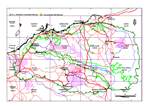Click on images
to enlarge



Photographer: B.R. Maslin

Photographer: B.R.Maslin

Photographer: M.W. McDonald

Photographer: M.W. McDonald
Botanical name
Acacia eriopoda x trachycarpa
Description
Attractive obconic shrubs or trees 2.5-6 m tall, with2-4 main stems (slightly crooked) from ground level, the upper branches sometimes spreading horizontally (not unlike those of A. trachycarpa). Bark pseudo Minni Ritchi (i.e. grey and peeling in short, irregularly longitudinal plates which are flat or more commonly slightly recurved at the ends, the underlying new bark pale brown). Branchlets glabrous. New shoots glabrous, resinous, slightly sticky when fresh. Stipules triangular, 0.5-1 mm long. Phyllodes linear, 6-10 cm long, mostly 2-3 mm wide, occasionally a few 3-5 mm wide, ±straight, slightly rigid, wide-spreading to erect, slightly resinous (but not sticky), slightly shiny, glabrous, dark green; parallel longitudinal nerves numerous and (at least when dry) slightly raised, central nerve more pronounced than the rest and nerves on either side of it reasonably widely spaced (space between the nerves at least 2-3 times wider than the width of the nerve), few anastomoses on broadest phyllodes, the upper phyllode margin broad (about 0.3-0.4 mm wide) as in A. trachycarpa for ¼-1/3 length of phyllode (occasionally for the entire length of the phyllode); apex acute to obtuse-mucronate, not spiny. Gland very obscure, situated on upper margin of phyllode 0-2 mm above pulvinus. Inflorescences simple, 1-3 per axil; spikes light golden, 15-20 mm long, showy; peduncles short (3-5 mm long), glabrous or with sparse, short, appressed to ±wide-spreading hairs, the hairs sometimes embedded in resin thus difficult to see; receptacle glabrous or sub-glabrous; basal peduncular bract sub-persistent, small, brown. Flowers 5-merous; calyx dissected for about ½ its length, the tube moderately white hairy; petals glabrous, 1-nerved (nerve quite evident when dry). Pods and seeds not seen.
Characteristic features
Bark pseudo Minni Ritchi (i.e. grey and peeling in short, irregularly longitudinal plates which are flat or more commonly slightly recurved at the ends), new bark pale brown. Branchlets glabrous. Stipules 0.5-1 mm long. Phyllodes linear, long and narrow (mostly 6-10 cm x 2-3 mm), ±straight, ascending to erect, glabrous, parallel longitudinal nerves numerous and (at least when dry) slightly raised, nerves reasonably widely spaced (space between nerves at least 2-3 times width of nerve), upper margin broad (about 0.3-0.4 mm wide) as in A. trachycarpa. Spikes 15-20 mm long; peduncles short (3-5 mm), glabrous or with sparse, appressed or sub-appressed hairs (hairs often embedded). Pods and seeds not seen.
Distribution and ecology
Confined to the Pilbara region of northwest Western Australia. It is an uncommon hybrid being known from Woodstock Station and from between Marble Bar and Nullagine. This putative hybrid has been observed to occur at low frequencies in populations of A. eriopoda or A. trachycarpa. Grows in unconsolidated (stony) sand along creek in low granite hills.
Flowering and fruiting period
Existing specimens show flowering as commencing in mid-May or early June. Judging from these specimens it is likely that flowering would extend to about August. Pods have not been seen.
Taxonomy
The putative hybrid status of this entity is suggested by field observations and from a critical examination of bark, phyllode and peduncle morphology. The bark is grey in colour (as in A. eriopoda) and exfoliates in short, narrow strips which, unlike A. trachycarpa, are mostly very slightly recurved at the ends (A. trachycarpa has typical Minni Ritchi bark which is burgundy to red-brown in colour, it is shed in strips that are strongly recurved at the ends to form scrolls while still attached to the stem). Flowering branches of the putative hybrid have the general facies of A. eriopoda in that the phyllodes are ±straight and linear, long and narrow, and not resinous, and the flower spikes are on very short peduncles. However, the phyllodes of the putative hybrid have a distinctly broadened upper margin (as in A. trachycarpa , but not in A. eriopoda) and the nerves are fewer, more pronounced (i.e. slightly raised at least when dry) and more widely spaced than in A. eriopoda; also the peduncles hairs are commonly sparser and more appressed than those of A. eriopoda. Acacia trachycarpa also hybridizes with A. monticola and A. tumida var. pilbarensis in the Pilbara.
Conservation status
Not considered rare or endangered.
